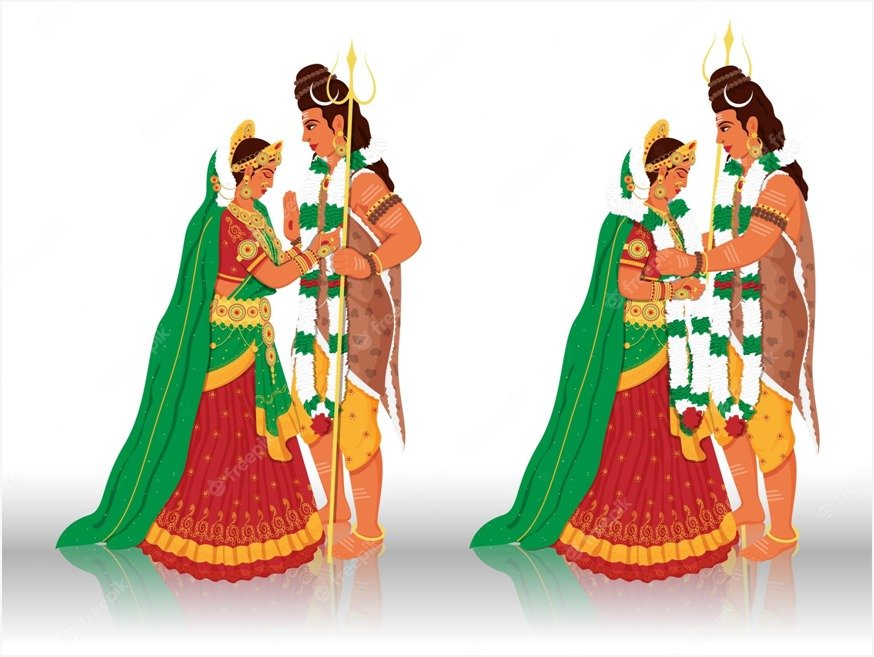Unveiling the Mythical Tale of Shiva and Parvati Marriage: A Love Story for the Ages

As a Hindu, I grew up hearing stories about the divine couple, Shiva and Parvati. Their love story is one of the most famous in Hindu mythology, and it has been retold in countless books, movies, and television shows. In this article, I will delve deeper into the tale of Shiva and Parvati’s marriage, exploring the origin of the couple, their courtship, the obstacles they faced, and the significance of their union.
Origin of Shiva and Parvati
Shiva is one of the three main gods in Hinduism, alongside Brahma and Vishnu. He is known as the god of destruction and is often depicted with a third eye and a crescent moon on his forehead. Parvati, on the other hand, is the goddess of love, fertility, and devotion. She is also known as Uma, Gauri, and Durga, among other names.
According to Hindu mythology, Shiva and Parvati’s union was preordained by the gods. Parvati was born as the daughter of the mountain king Himavan and his wife Menavati. From a young age, Parvati was devoted to Shiva and wished to marry him. However, Shiva was a recluse who lived in the mountains and had no interest in marriage or worldly affairs.
The Meeting of Shiva and Parvati
Despite Shiva’s indifference, Parvati was determined to win his heart. She left her home and went into the mountains, where she began to live as a hermit. She practiced meditation and performed austerities to gain Shiva’s favor. Eventually, Shiva took notice of Parvati and was impressed by her devotion and dedication.
Shiva and Parvati first met on the banks of the river Ganga, where Parvati was performing a ritual. Shiva was passing by and was immediately struck by Parvati’s beauty and grace. They began to talk, and as they spoke, they realized that they were kindred spirits. They had a deep connection and were drawn to each other.
Courtship of Lord Shiv and Parvati
After their first meeting, Shiva and Parvati began to spend more time together. They would go on long walks in the mountains, talk about philosophy and spirituality, and share stories and poems. As they got to know each other better, they fell in love.
Shiva was hesitant to express his feelings for Parvati, as he was afraid that his destructive nature would harm her. However, Parvati was persistent and convinced Shiva to open up to her. She assured him that she understood him and accepted him for who he was.
Obstacles in the Marriage of Shiva and Parvati
Despite their deep love, Shiva and Parvati faced many obstacles on their path to marriage. One of the biggest obstacles was Shiva’s reputation as a hermit and a destroyer. Many people feared him and thought that he was dangerous. Shiva’s own family, including his brother Vishnu and sister-in-law Lakshmi, were wary of his relationship with Parvati.
Another obstacle was the presence of other suitors vying for Parvati’s hand in marriage. Parvati was a beautiful and virtuous woman, and many princes and gods sought her hand. However, Parvati remained loyal to Shiva and rejected all other proposals.
The Wedding of Shiva and Parvati
In the end, Shiva and Parvati’s love triumphed over all obstacles. Shiva’s family eventually came around and accepted Parvati as their own. Shiva’s friend and ally Nandi, the bull, helped to convince Shiva to marry Parvati.
The wedding of Shiva and Parvati was a grand affair, attended by all the gods and goddesses. It is said that the earth shook and the skies rumbled as they exchanged vows. The wedding was a symbol of the union of the masculine and feminine energies in the universe, and it marked the beginning of a new era.
Significance of Shiva and Parvati's Union
Shiva and Parvati’s union is significant for many reasons. Firstly, it is a symbol of the power of love to overcome all obstacles. Shiva and Parvati’s love was not based on physical attraction or material gain, but on a deep spiritual connection. Their love transcended all boundaries and was a testament to the power of devotion and dedication.
Secondly, Shiva and Parvati’s union is a symbol of the balance of the masculine and feminine energies in the universe. Shiva represents the masculine energy of destruction and transformation, while Parvati represents the feminine energy of creation and nurturing. Their union represents the union of these forces and the creation of a harmonious universe.
Popular Legends and Stories Related to Shiva and Parvati
There are many popular legends and stories related to Shiva and Parvati. One of the most famous is the story of their son, Ganesha. According to legend, Parvati created Ganesha from her own body to keep her company while Shiva was away. When Shiva returned, he was furious to find a strange boy guarding Parvati’s chambers.
In a fit of rage, Shiva cut off Ganesha’s head. However, when he saw Parvati’s grief, he promised to bring Ganesha back to life. He replaced Ganesha’s head with that of an elephant, giving birth to the elephant-headed god we know today.
Another popular story is the tale of Shiva’s cosmic dance, the Tandava. According to legend, Shiva performed the Tandava to destroy the universe at the end of a cosmic cycle. However, Parvati intervened and convinced Shiva to stop. She reminded him of his duty to protect and preserve the universe, and Shiva relented. The Tandava thus became a symbol of the balance between destruction and creation.
The Legacy of Shiva and Parvati's Love Story
The legacy of Shiva and Parvati’s love story is immense. Their story has been retold in countless forms, from ancient texts like the Puranas and the Mahabharata to modern movies and TV shows. It has inspired generations of Hindus to seek spiritual connection and devotion in their own lives. The image of Shiva and Parvati together, with Shiva’s arm around Parvati’s shoulder, has become an iconic symbol of love and devotion.
Conclusion
In conclusion, the love story of Shiva and Parvati is a tale for the ages. It is a story of devotion, dedication, and the power of love to overcome all obstacles. Their union represents the balance of masculine and feminine energies in the universe and serves as a symbol of the creation of a harmonious world. As a Hindu, I am proud to be part of a tradition that values love, devotion, and spiritual connection above all else.

